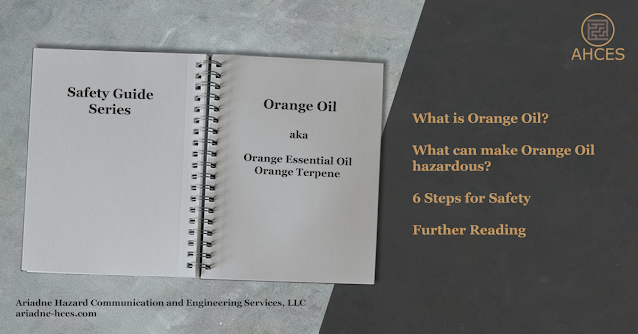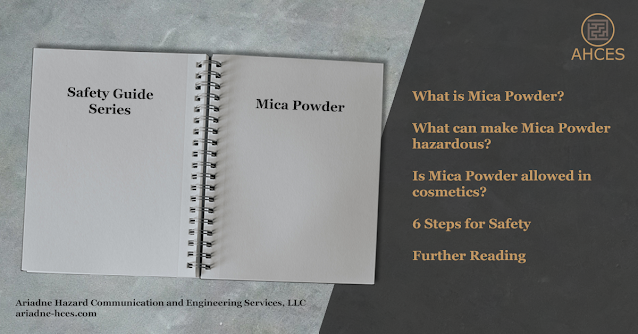Orange Oil Safety Guide
What is Orange Oil?
Orange oil, also known as orange essential oil and orange terpene, is a mixture of naturally occurring oils found in the rind of the orange fruit. The primary component of the oil mixture is d-limonene. Orange oil is popular as a fragrance used in aromatherapy, candle making, and soap making. It is also sold as a cleaning agent, often being the primary ingredient in many products sold as a "natural cleaner" or "natural degreaser."
Orange terpene, as a mixture of naturally derived oils, has the CAS Number 8028-48-6.
Pure D-Limonene has the CAS Number 5989-27-5.
The CAS Number is used to identify orange oil as an ingredient on safety data sheets (SDS) and other safety documents. When looking for orange oil as an ingredient in fragrances, cleaning agents, or other products, look for the above CAS Numbers within the composition table.
Notable Properties of Orange Oil
Orange oil is valued for its fragrance, smelling like citrus, as well as being a degreaser, able to remove other oils from surfaces. Orange oil is naturally colorless, though is popularly dyed orange or yellow when sold as a final consumer product.
What can make Orange Oil Hazardous?
Orange oil is flammable and may act as a fuel source in the event of a fire. The smoke from a fire may also contain harmful compounds caused by the burning of orange oil, including carbon dioxide and carbon monoxide, along with other carbon compounds.
The degreasing properties of orange oil make it a skin irritant, able to remove the natural oils present on the skin. Additionally, orange oil may cause an allergic skin reaction, particularly in those who have a citrus allergy. Orange oil is also irritating to the eyes.
Orange oil may be harmful if ingested, causing intense irritation to many tissue types and may cause circulatory collapse. The NOAA Cameo Chemicals Entry for d-limonene, the primary component of orange oil, lists different symptoms of d-limonene poisoning by swallowing and inhalation.
Symptoms of poisoning by swallowing include abdominal burning and nausea, and may lead to unconsciousness and convulsions.
Symptoms of poisoning by inhalation include dizziness, and rapid and shallowing breathing, and may lead to unconsciousness and convulsions.
D-Limonene is among several essential oils known to be highly toxic to cats. Orange oil is also hazardous to aquatic organisms and should not be introduced to water systems.
Orange Oil Frequently Asked Questions
Can Orange Oil be Used on Skin? What is the Best Orange Oil for Skin?
High purity orange oil should not be applied directly to the skin. As described above in the hazard information, orange oil can strip the natural oils from the skin. This can result in irritation and dry, cracking skin.
Does Orange Oil Repel Insects? Can Orange Oil be Used as an Insecticide?
Yes, orange oil can repel insects. In sufficient concentrations, it can damage the natural oils on their carapace and respiratory system, with use as an insecticide.
Is Orange Oil Safe for Pets?
Orange oil is not safe for pets. As described above,
d-limonene is highly toxic to cats as well as aquatic life including fish. If you have
pets, consider alternative products to orange oil for cleaning or
home fragrance, or ensure that your pets are kept away from areas where orange oil is being used.
6 Steps for Safety
Step 1: Read the Warnings
When working with a product for the first time, always read all the safety documents first. This includes safety data sheets, which should be provided by the manufacturer or importer of the orange oil. There may also be an OSHA chemical label, FDA cosmetics label, or a Consumer Protection label on the packaging of the orange oil product. These documents all contain important information on the hazards of the product and instructions on how to mitigate those hazards.
Different compositions in different productions may cause additional hazards to be present beyond the properties of plain orange oil. Be sure to familiarize yourself with the differences between separate orange oil products.
For example, denatonium benzoate, which is used as a bitterant to deter the consumption of orange oil cleaners, and other cleaning products, is corrosive in higher concentrations. A cleaning agent that contains both orange oil and denatonium benzoate may have different safety precautions than pure orange oil.
Step 2: Prepare Your Workspace
Creating a safe workspace, sometimes referred to as engineering control, is a key component of working safely with any potentially hazardous substance.
The primary physical hazard of orange oil is its flammability. Ensure that the workplace is free of any ignition sources, such as open flames. A dry chemical carbon dioxide extinguisher is recommended for use on orange oil fires. Do not use water, as in a grease fire, it can cause the burning oil to spread rather than extinguishing it.
Step 3: Gather Your PPE
When working with pure orange oil, here is the recommended personal protective equipment (PPE):
- Respiratory Protection
- A half-face respirator with an appropriate filter for organic vapors.
- A full-facepiece respirator can serve as both respiratory and eye protection.
- Eye Protection
- Safety goggles that create a seal around the eyes are needed to prevent any orange oil, either as a vapor or liquid splash, from reaching the eyes.
- Open safety glasses, which do not have a sealing surface, will not work in preventing vapor or splashes from reaching the eyes.
- Gloves
- Basic disposable gloves will prevent orange oil from touching the skin on the hands and causing irritation.
- Pure orange oil does not have any known chemical interactions with the material for use in most disposable gloves.
- In the event of a tear or puncture in the gloves, remove the damaged gloves, thoroughly wash hands to remove any orange oil, and replace them with a new pair of gloves.
- Long Sleeves
- Long sleeves will prevent orange oil from touching the skin on the arms and causing irritation.
- Non-absorbent material is recommended to prevent orange oil from remaining in the fabric and being held against the skin.
- A splash-resistant coat or disposable sleeves are recommended.
- Apron
- Non-absorbent material is recommended to prevent orange oil from remaining in the fabric and being held against the skin.
- A splash-resistant or rubberized apron is recommended to prevent orange oil from splashing on the body.
Step 4: Clear Your Workspace
Having a clear workspace is an important part of safety. Clutter can cause accidents and can prevent you from noticing if something has spilled.
This is also a good time to double-check check any engineering controls present are in working order and to ensure that no ignition sources are around.
If you are working in a shared space, make sure anyone around you can also remain safe when you are working with orange oil. For those working at home, this can include family members and pets.
Step 5: Do the Work
If engineering controls and PPE are used properly, working with orange oil has minimal hazards.
If work cannot be completed in one sitting, be sure to properly seal any orange oil containers to prevent spills or accidental release when not in use.
Step 6: Clean Up
Orange oil may leave residue from any drips or small spills. Clean up orange oil with an absorbent material, such as paper towels, or a granular absorbent such as cat litter.
Do not wash orange oil down the drain, as it is toxic to aquatic organisms.
Be sure to dispose of any waste in accordance with local regulations.
Further Reading
The National Library of Medicine has a PubChem article on both Orange Oil and D-Limonene.
Check out the Safety Guide Series Hub for more safety guides.
Sources Cited
K. B. (n.d.). Essential Oils and Cats. Retrieved February 22, 2023, from https://www.petpoisonhelpline.com/blog/essential-oils-cats/
National Center for Biotechnology Information (2024). PubChem Compound Summary for CID 62161, 2,6-Dimethyl-10-methylidenedodeca-2,6,11-trienal. Retrieved February 22, 2023 from https://pubchem.ncbi.nlm.nih.gov/compound/2_6-Dimethyl-10-methylidenedodeca-2_6_11-trienal.
National Center for Biotechnology Information (2024). PubChem Compound Summary for CID 440917, Limonene, (+)-. Retrieved February 22, 2023 from https://pubchem.ncbi.nlm.nih.gov/compound/4R_-1-methyl-4-prop-1-en-2-ylcyclohexene.
National Oceanic and Atmospheric Administration (n.d.). Chemical Datasheet D-Limonene. CEMEO Chemicals. Retrieved February 22, 2023, from https://cameochemicals.noaa.gov/chemical/20568
Original Posting Date: Feb. 22, 2023
Last Updated: Feb. 12, 2024





Comments
Post a Comment